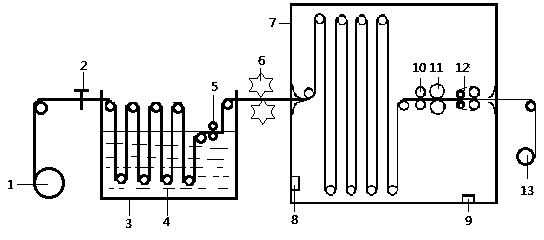Fibrilia stretching and refining processor
A processing device, a technology for hemp fibers, applied in the directions of liquid/gas/vapor fiber/sliver/roving treatment, solvent treatment, textile material treatment, etc. To eliminate damage and other problems, to achieve the effect of improved flexibility, less damage to hemp fibers, and guaranteed potential loss
- Summary
- Abstract
- Description
- Claims
- Application Information
AI Technical Summary
Problems solved by technology
Method used
Image
Examples
Embodiment 1
[0015] Example 1: Effect of jute fiber treatment.
[0016] Processing technology: winding speed: 5 m / min; dispersing comb tooth density: 30 teeth / cm; after water press roller treatment, fiber liquid content: 10%; licker-in tooth density: 70 teeth / cm; in the drawing chamber : Steam temperature 110℃, relative humidity 90%. Stretching ratio: primary stretching: 1.4 stretching gauge, stretching gauge is 1.2 times the average length of hemp fiber bundles; secondary stretching: 1.8 stretching gauge, stretching gauge is 1.7 times the average length of hemp fiber bundles times. Referring to this process, the properties of the treated fibers are compared with those of the fibrils, and the results are shown in Table 1 below.
[0017] Table 1:
[0018]
[0019] It can be seen from the test that the fineness of the stretched fibers has been greatly changed, reducing by nearly 30%. The elongation at break of the fiber increases and the initial modulus decreases, which makes the fibe...
Embodiment 2
[0020] Example 2: Treatment effect of hemp technology fibers.
[0021] Processing technology: winding speed: 5 m / min; dispersing comb tooth density: 40 teeth / cm; after water press roller treatment, fiber liquid content: 15%; licker-in tooth density: 70 teeth / cm; in the drawing chamber : Steam temperature: 120°C, relative humidity 90%; stretching ratio: primary stretching: 1.2 stretching gauge, stretching gauge is 1.2 times the average length of hemp fiber bundles; secondary stretching: 1.6 stretching gauge , the tensile gauge is 1.7 times the average length of hemp fiber bundles. Referring to this process, the properties of the treated fibers are compared with those of the fibrils, and the results are shown in Table 2 below.
[0022] Table 2:
[0023]
[0024]It can be seen from the test that the drawn fibers have a great change in fineness. The elongation at break of the fiber increases and the initial modulus decreases, which makes the fiber show better toughness and e...
Embodiment 3
[0025] Example 3: Flax technology fiber treatment effect.
[0026] Treatment process: winding speed: 5 m / min; dispersing comb: tooth density: 30 teeth / cm; after water press roller treatment, fiber liquid content: 15%; licker-in tooth density: 80 teeth / cm; in the drawing chamber : steam temperature 130℃, relative humidity 95%; stretching ratio: primary stretching: 1.5 stretching gauge, stretching gauge is 1.3 times the average length of hemp fiber bundle; secondary stretching: 1.7 stretching gauge, The tensile gauge is 1.8 times the average length of the hemp fiber bundles. Referring to this process, the properties of the treated fibers are compared with those of the fibrils, and the results are shown in Table 3 below.
[0027] table 3:
[0028]
[0029] It can be seen from the test that the drawn fibers have a great change in fineness. The elongation at break of the fiber increases and the initial modulus decreases, which makes the fiber show better toughness and elastic...
PUM
 Login to View More
Login to View More Abstract
Description
Claims
Application Information
 Login to View More
Login to View More - R&D Engineer
- R&D Manager
- IP Professional
- Industry Leading Data Capabilities
- Powerful AI technology
- Patent DNA Extraction
Browse by: Latest US Patents, China's latest patents, Technical Efficacy Thesaurus, Application Domain, Technology Topic, Popular Technical Reports.
© 2024 PatSnap. All rights reserved.Legal|Privacy policy|Modern Slavery Act Transparency Statement|Sitemap|About US| Contact US: help@patsnap.com










